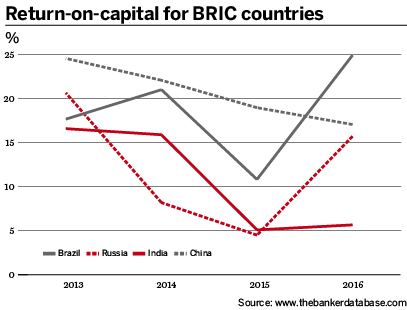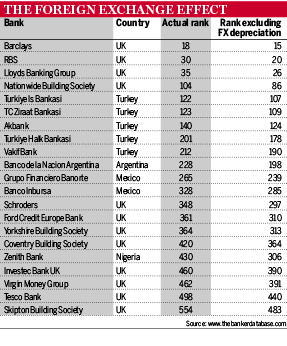Last year saw a reversal of fortune for the Brazilian and Russian economies, helping their banks to stage a comeback
This year’s Top 1000 gives cause to herald the return of the BRIC (Brazil, Russian, India and China) banks. The emerging market acronym has fallen by the wayside in recent years, as China’s and India’s economies soldiered on while Brazil and Russia endured their worst recessions in decades. Yet 2016 marked a reversal of fortunes for the two laggard countries, helping their banks to stage a comeback.
Profits at the 11 Brazilian banks in the rankings surged 179.4%, up from the $10.5bn posted in 2015. Meanwhile, Russian banks’ profits are up 369% to post a total of $14.65bn. Their standouts are Banco BTG Pactual and Gazprombank, which posted among the biggest five moves from loss to profit in this year’s rankings.
These figures have been boosted by foreign exchange fluctuations. The real and rouble were the best performing emerging market currencies of 2016, gaining 16.4% and 16.8% respectively against the dollar (the reference currency for compiling the Top 1000). However, as neither Brazil nor Russia’s currency has recovered to normalised levels, their banks’ strong profit performance is not down to foreign exchange moves alone. This is supported by their profitability ratios, which are not impacted by currency fluctuation. Based on Brazil’s improved ROA and ROC, its banking sector is now more profitable than China’s, while Russia’s ROA is nearly double the global average.
Their rebound is not limited to profits. Of the 16 Russian banks in this year’s Top 1000, 13 posted capital growth that outstrips the rouble’s gains. Its biggest lender, Sberbank, has soared 15 spots to place 36th in the global rankings. Russia’s improving capitalisation was apparent in last year’s Top 1000, when Tier 1 and assets shrunk far less than the rouble’s collapse. It seems no coincidence that its improvement coincides with the central bank’s efforts to clean up the sector. From 2014 to 2016, the regulator withdrew more than 300 banking licences from institutions that were chronically weak or unscrupulously led.
Brazil’s banks weathered its economic crisis better than Russia’s, so there’s been little need to shore up its capital base. Nonetheless, Tier 1 capital at its biggest bank, Itaú Unibanco, grew 37.33%, more than recouping its 28.52% drop the year before.
India’s profitability continues to be hit by rising impairment charges and provisions (ICP), the loss recognised on loan books to account for NPLs and other impaired assets. This process started in 2015 on the central bank’s instruction to clean up balance sheets, and was a major cause of the sector’s profit slump in last year’s rankings. The exercise will continue for some time, but profits edged up in 2016 and three Indian banks – Bank of Boroda, Punjab National Bank and Canara Bank – are among the year’s 10 biggest recoveries.
For extended coverage of The Banker's Top 1000 World Banks 2017, click here




